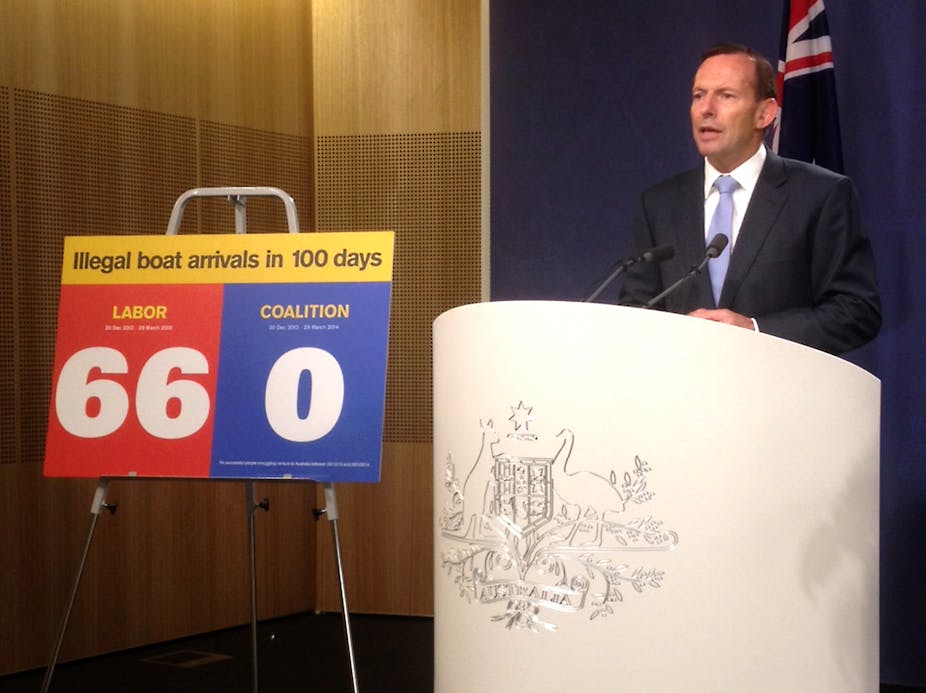The Abbott government has celebrated the 100th day without any asylum seeker boats reaching Australian territory. This is the result of policies that favour the protection of borders rather than of people. So what happens to those asylum seekers stuck in transit countries such as Indonesia?
While recently visiting asylum seekers in Puncak, an area about 60 kilometres from Jakarta that has housed thousands of asylum seekers and refugees in the last few years, I came across a group of men from the Darfur region of Sudan. Tired of their plight as refugees in camps in Sudan, they had managed to come all the way to Indonesia in mid-2013.
They invited me to the place where they stayed. Over a glass of water, I asked them how they managed to pay the rent for their room and buy food.
To my surprise, they said they were basically broke. They were thinking of turning themselves in to the immigration authorities. After all, they thought, it was better to be detained than to starve.
A cross-check of recent interception statistics in Indonesia confirmed this. Since late 2013, most asylum seekers have in fact surrendered themselves to authorities rather than being captured. Whereas police and immigration officials had been very active in intercepting and arresting thousands of asylum seekers who were trying to leave Indonesia by boat, these activities are now no longer required.
These asylum seekers, an Indonesian migration representative explained, “are so desperate that they sacrifice their freedom for food”.
Once asylum seekers surrender to authorities, they will likely be held in an immigration detention centre.
System at breaking point
Indonesian authorities are not keen to detain these asylum seekers. Their centres are already overcrowded and community detention is available only in certain areas. At the end of February, the 13 Indonesian detention centres held 1926 persons, including 1327 asylum seekers and 599 refugees, of whom 326 were female and 364 were children (including 100 unaccompanied minors).
The International Organisation for Migration (IOM), which is generously funded by Australia, reimburses the costs of these efforts to accommodate asylum seekers. Indonesians are increasingly worried, though, that the stranded asylum seekers might stay for the long term.
More than 10,500 asylum seekers and refugees are registered with the United Nations High Commissioner for Refugees (UNHCR) in Indonesia. According to the UNHCR, the latest figures include 7,241 asylum seekers and 3,326 refugees, the majority of them men.
The number of people arriving in Indonesia seeking international protection has, however, decreased substantially over the last four months, as they know it is most unlikely they will find protection in Australia.
Homeless and penniless
What will happen to those already in Indonesia?
The time between registration and the first interview in the refugee status determination process is almost a year. In late February, 5961 individuals were still waiting to be interviewed by an UNHCR officer to process their claims for international protection. People who register now with the UNHCR will only be interviewed in 2015.
During this time, asylum seekers do not receive any financial and material support but must cover their own expenses. In previous years every recognised refugee was entitled to a monthly payment to cover accommodation and living costs. Due to funding restrictions, the UNHCR can support only very few cases.
This leaves many asylum seekers stranded and penniless, especially when their families back in their country of origin or another destination country stop supporting them.

Little hope of resettlement
Resettlement to safe third countries proceeds as slowly as in the past. Over the course of 2013, the UNHCR resettled less than 10% of registered persons – mainly to Australia, but also Sweden, the US and New Zealand.
In the first two months of 2014, only 96 refugees have departed for resettlement. The applications of 150 refugees were submitted to potential resettlement countries, while 943 refugees were still waiting on resettlement decisions.
Hopelessness gives rise to many rumours – for example, that boats will try to go all the way to New Zealand instead of to Australia. One way to prevent asylum seekers falling prey to people smugglers is to provide clear and easily accessible information about the asylum seeking process in Indonesia.
Improving lives in limbo
From my observations over the last few years, many have insufficient knowledge about their rights and obligations as asylum seekers. For example, families should generally be exempted from detention and allowed to stay in community detention. But you can only request this option if you know it exists.
Another possibility to improve asylum seekers’ lives in Indonesia would be to grant them formal work permits and access to proper education. Among the current asylum seekers are many young people who wish to study. Some might even have the financial means to do so or perhaps could receive a scholarship from a philanthropic organisation or private benefactors.
Nonetheless, such proposed changes can only temporarily improve the plight of asylum seekers. Faster processing of claims and larger quotas for resettlement are essential. In face of multiple crises in the Middle East and ongoing conflicts in Africa it is unlikely asylum seekers will stop seeking refuge outside their countries of origin.
Due to Australia’s “stop the boats” policies, a few asylum seekers may try to reach Europe. Many more, however, will get stuck in unsafe transit countries, where they will experience additional hardship. Can Australia justify its “success” by merely shifting the problems off its borders?

